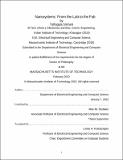Nanosystems: From the Lab to the Fab
Author(s)
Srimani, Tathagata
DownloadThesis PDF (7.390Mb)
Additional downloads
Advisor
Shulaker, Max M.
Terms of use
Metadata
Show full item recordAbstract
Exponential improvements in computing performance have impacted and improved nearly every aspect of our lives: from education to transportation to healthcare. And with continued gains, applications which were once science fiction – from fully-autonomous vehicles to personalized healthcare – will soon be a reality. Yet at the exact moment these next-generation applications are poised to once again revolutionize our lives, gains in computing performance are slowing. The conventional approaches relied on to improve computing – mainly relentless physical and equivalent scaling of devices – are reaching fundamental limits, and while progress will undoubtedly continue, the rate of gains has already slowed dramatically over the last decade. Therefore, to enable these next-generation applications, new approaches to computing systems are required. Rather than rely on a single approach, coordinated advances across the system stack – from new technologies to new system architectures – are required to overcome today’s challenges. This is embodied by “NanoSystems”, which use emerging nanotechnologies to realize new system architectures to enable new applications.
Yet however intellectually compelling or interesting nanosystems are, the problems facing computing today are very real and very current. Unfortunately, despite the promise of nanosystems, nanosystems were exclusively of academic interest. All nanosystem demonstrations were fabricated in academic labs, and there were many challenges that prohibited nanosystems from transferring into industry and thus into the real world.
This thesis addresses this critical problem. By demonstrating the world’s first adoption of nanosystems within industry, this thesis provides both a specific path forwards as well as a general approach of how to transform promising nanosystems in theory into practical systems that can impact our daily lives. To transform nanosystems from the “lab” to the “fab”, this thesis must address challenges that span the entire stack: from low-level material optimizations, to semiconductor device engineering, to circuit and system design, up to architectures and application implementation. As a case-study, this thesis focuses on carbon nanotubes and monolithic threedimensional integration as the specific implementation of a nanosystem, yet the lessons and conclusions from this work are applicable to a broad set of emerging nanotechnologies and nanosystems. Beyond technology, this thesis shows unequivocally that nanosystems should – and can - be transferred from academic “labs” into commercial “fabs”, providing a realistic and feasible path forwards for computing to continue to improve and revolutionize the world we live in.
Date issued
2022-02Department
Massachusetts Institute of Technology. Department of Electrical Engineering and Computer SciencePublisher
Massachusetts Institute of Technology